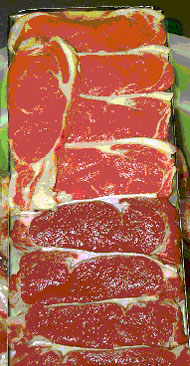
Dark cutting beef - the economic loss
Extensive consumer research conducted by Meat & Livestock Australia in the late 1990s, indicated beef consumers dislike dark, high pH beef. In fact, more than 1-in-2 of these steaks were rejected at taste panel testing. As a direct result, many meat companies now demand beef that has acceptable meat colour and pH for their customers.

Dark cutting beef affects producer returns
Dark cutting beef (DCB) is a cost to the beef industry due to poor retail display properties, shorter storage life and poor cooking qualities.
Producers trading over-the-hooks on beef carcase specification have experienced price discounts of 5% to 20% of carcase weight—or $45 to $180 for a 300 kg carcase. These discounts flow down the supply chain, with a wholesaler having to downgrade the carcase value by possibly $200 for the same 300 kg carcase. This is due to the loss of up to 50% of the prime cuts to manufacturing beef.
Cost to the NSW beef industry
In 1999–2000 some 1,724,600 cattle were slaughtered in NSW at an average carcass weight of 251 kg. At a 10% incidence of DCB, the NSW cattle industry has foregone about $15 million in potential returns due to this cause.
A recent Victorian study estimated that the Australian beef industry is losing about $38.5 million every year due to DCB. This estimate was based on an average loss of $90 per carcase on heavy domestic and export trade cattle The total losses across all stock categories would be far greater.

